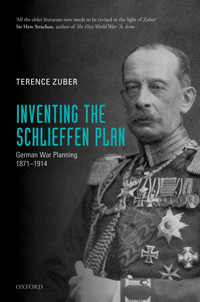World War: Alsace-Lorraine
The Siege of Liège 1914
1891-1914
1999-2011
Ardennes 1914
1904-1914

 Inventing the Schlieffen Plan: German War Planning 1871-1914
Inventing the Schlieffen Plan: German War Planning 1871-1914
(Hardcover)
by Terence Zuber (Military Historian)
"The history of German war planning prior to the First World War has been dominated by the 'Schlieffen plan', which was developed in a Denkschrift...
Since 1920 it has been "common knowledge" that the German war plan in 1914 was the Schlieffen plan. After the war German generals contended that they lost the Battle of the Marne in 1914 only because the younger Moltke failed to understand Schlieffen's brilliant plan. In 1956 Gerhard Ritter claimed that the Schlieffen plan proved German war guilt: it was the apotheosis of aggressive German militarism and forced Germany to turn a Balkan quarrel into a World War by attacking France.
The Schlieffen plan is one of the great commonplaces of European history. It provides a simple explanation of the German strategy in 1914. Armchair strategists love it. It is a commonly used high school and college history research topic and exam questions. It is proof of German war guilt and a handy weapon for opponents of "German militarism".The Schlieffen plan dogma also has massive internal inconsistencies. The plan was not written until after Schlieffen had retired. It assumed a one-front war in which the French were on the defensive; in 1914 the Germans faced a two-front in which the French and Russians were attacking. Indeed, if, as Ritter contended, an aggressive war plan is proof of war guilt, then it is the French and Russians who are guilty, for they attacked first: all of the initial battles were fought on German territory. The Schlieffen plan also employed 24 divisions that did not exist, either in 1906 or 1914. These inconsistencies have been brushed aside, indeed many of the advocates of the Schlieffen plan do not appear to have actually read the plan itself. Usually the "proof" for the existence of the Schlieffen plan is a superficial comparison of maps the Schlieffen plan and the German campaign in 1914.
Based on original planning documents, some of which only became available in Germany with the fall of the Wall, I showed in 1999 in 'The Schlieffen Plan Reconsidered' and in 2002 in Inventing the Schlieffen Plan that there never was a "Schlieffen plan". The "Schlieffen plan" was never implemented as a real German war plan, and was not the German war plan in 1914. Schlieffen never tested the "Schlieffen plan" in a war game. Schlieffen's real intent was to counterattack against the expected Franco-Russian attacks. The original "Schlieffen plan" document was a rough draft that was not typed until 1911. Indeed, in August 1914 the original document was the property of Schlieffen's daughters, who stored it with the family photos.
History professors and military historians who had written explanations of the structure and meaning of the "Schlieffen plan", which were now been shown to be wrong, did not take kindly to having their sacred cow slaughtered.
The "Schlieffen plan" debate in 'War in History' continues to this day. The German Army called an international conference in 2004 to address my thesis. Inventing the Schlieffen Plan received several favorable reviews, including one from Sam Williamson in 'The Journal of Military History' and one in the Times Literary Supplement. There has also been much discussion of the Schlieffen plan debate on the internet.
Inventing the Schlieffen Plan is one of the most important books ever published concerning German planning and operations at the beginning of the Great War. 340 pages, 13 maps, index.
Inventing the Schlieffen Plan (Oxford University Press, 2002)
